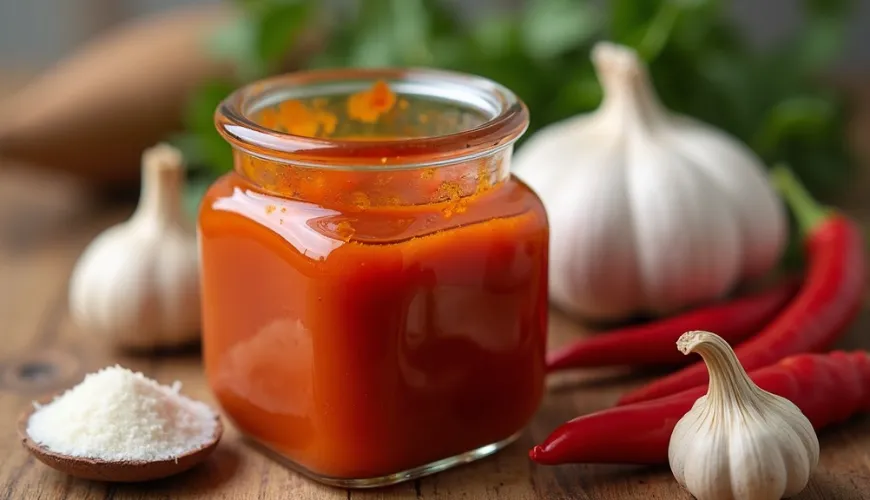
Prepare homemade ponzu sauce and enjoy its benefits

What is Ponzu and Why Should This Japanese Sauce Have a Place in Your Kitchen?
In recent years, global gastronomy has increasingly opened up to new flavors and exotic combinations. It's no surprise that Japanese sauces, previously known only to sushi lovers or Japanese cuisine enthusiasts, are gaining attention. One such sauce winning the hearts of chefs (and the taste buds of diners) worldwide is ponzu sauce – a subtle yet impactful flavor bomb. What makes it special, how can you use it at home, and can you make it yourself?
Ponzu - The Sour Elegance of Japanese Cuisine
Ponzu is a traditional Japanese sauce known for its complex flavor, which combines saltiness, acidity, mild sweetness, and typical umami. Its base consists of soy sauce complemented by citrus juice (typically from Japanese yuzu, but sudachi, kabosu, or regular lime can also be used), rice vinegar, mirin (sweet rice wine), and a broth of kombu seaweed or dried bonito flakes.
Thanks to this balanced combination of flavors, ponzu is incredibly versatile. In Japan, it's primarily used as a dip for meat, grilled fish, or sashimi, but it's also excellent as a salad dressing, marinade, or even as part of hot dishes. Its versatility is why ponzu sauce is finding its way into European and Czech households.
Ponzu Sauce at Home? It's Not Rocket Science
While ponzu sauce can easily be purchased in specialty stores or Asian food sections, making it at home has its advantages. You can adjust the ingredient ratios to your taste, ensure the quality of the ingredients, and avoid unnecessary preservatives and added sugars found in some commercial versions.
Homemade Ponzu Sauce Recipe
To make ponzu sauce yourself, you'll need just a few ingredients:
- 100 ml soy sauce (preferably high-quality fermented)
- 50 ml citrus juice (ideally yuzu, but lime or lemon can be substituted)
- 2 tablespoons rice vinegar
- 1 tablespoon mirin
- a piece of kombu (dried seaweed) or 1 tablespoon katsuobushi (bonito flakes)
Mix all the ingredients in a sealable jar and let it steep in the fridge for at least 24 hours. The flavors will meld beautifully, and the sauce will gain intensity. After straining, you can store it in the fridge for up to 2 weeks – but it usually disappears much sooner.
Why Does Ponzu Work Well in Czech Cuisine?
It might seem that ponzu is too exotic to find a place in the average Czech kitchen. However, its balanced flavor and natural freshness make it an ideal addition to dishes familiar from home. Ponzu is perfect as a marinade for roast chicken, a dressing for a salad with roasted beetroot, or even as a seasoning for mushroom broth. Its ability to add depth of flavor to any dish elevates it to the level of universal seasonings like garlic or pepper.
One example of using ponzu in a completely "non-exotic" dish is a salad of roasted cauliflower and chickpeas. When seasoned with ponzu sauce, you'll get a dish with an umami touch that surprises with its fullness – all while maintaining the simplicity of preparing a vegetable salad.
An Enticing Alternative to Other Sauces
Compared to other sauces – such as Worcestershire, balsamic vinegar, or hoisin sauce – ponzu has the advantage of being lighter and less aggressive, yet still rich in flavor. While Worcestershire can sometimes overpower the taste of other ingredients and balsamic vinegar is often too sweet, ponzu offers a gentle balance that supports other flavors without overshadowing them.
Additionally, ponzu is a sauce with minimal fat content, making it suitable for those looking to eat healthier or reduce calorie intake. With a base of fermented products and sea ingredients, it also offers benefits for digestion and immunity, aligning with the philosophy of eco-friendly and mindful shopping.
Ponzu in Restaurants and Homes
Ponzu is increasingly appearing in Czech restaurants – not just those with an Asian focus. Many chefs use it to season fish, beef, or even vegetable tapas. For example, a well-known Prague establishment with modern Asian cuisine created a seasonal menu in summer 2023, featuring ponzu as the main component in a dressing for a leafy salad with grilled tofu, sesame, and roasted sweet potatoes. Guests were impressed by how the sauce enhanced the vegetable flavors without overpowering them.
On the home front, its popularity is still in its early stages, but this makes culinary exploration even more interesting. Just as we've become accustomed to kimchi, miso, or tamari, ponzu sauce is another step toward a healthy, tasty, and simple cuisine.
What to Watch Out for When Choosing and Storing?
When buying ponzu, it's recommended to read the ingredients. Some cheaper versions may contain excess sugar, artificial flavors, or unnecessary preservatives. Ideally, it should contain only a few basic ingredients: soy sauce, citrus juice, vinegar, and a broth of sea ingredients. If the citrus juice is from yuzu, it's a premium variant – and a more authentic product in terms of taste.
Storage is simple – keep both homemade and purchased versions in the fridge in a sealed container, away from direct light. Thanks to the natural preservative properties of soy sauce and vinegar, it can last several weeks.
And if you're unsure how to use the sauce? Be inspired by a simple trick: try replacing regular vinegar or lemon in your favorite salad dressing with ponzu. You'll see how one spoonful of ponzu transforms an ordinary dinner into a culinary experience.
Ponzu is not just a fashion trend or another exotic sauce to add to your collection. It is a flavor experience that transcends culinary boundaries and traditions. Whether used as a dip, dressing, or secret ingredient in your homemade soup, it brings a new dimension to cooking. At a time when we seek new flavors while recognizing the importance of simplicity and health, ponzu sauce symbolizes how even a small change can have a significant impact.

